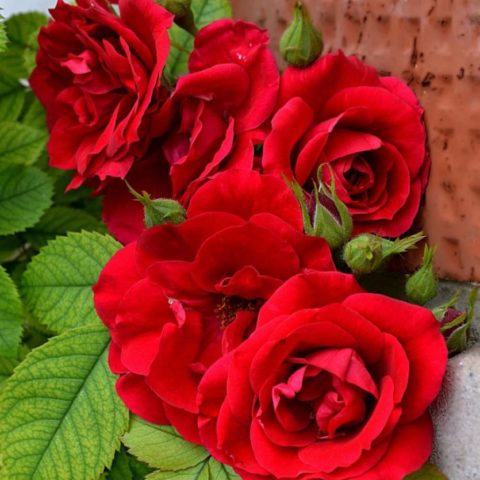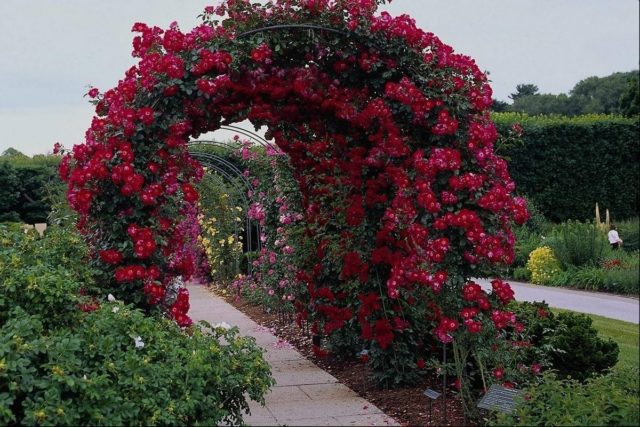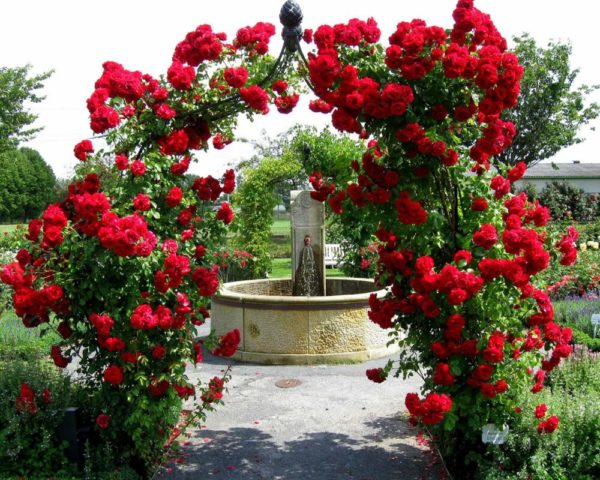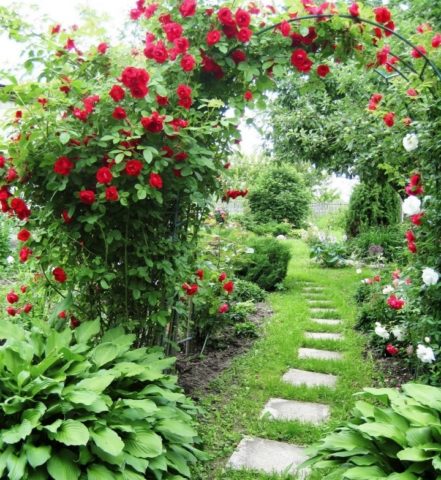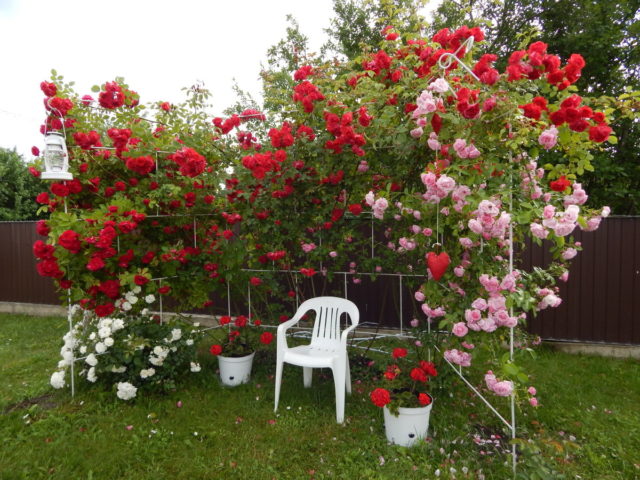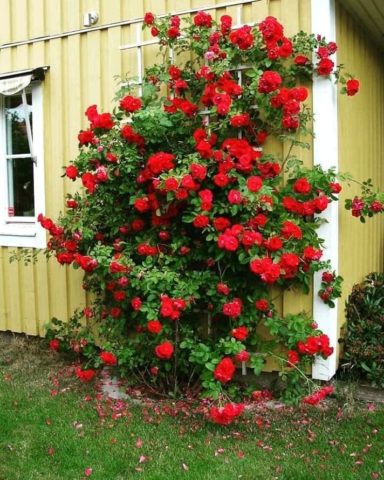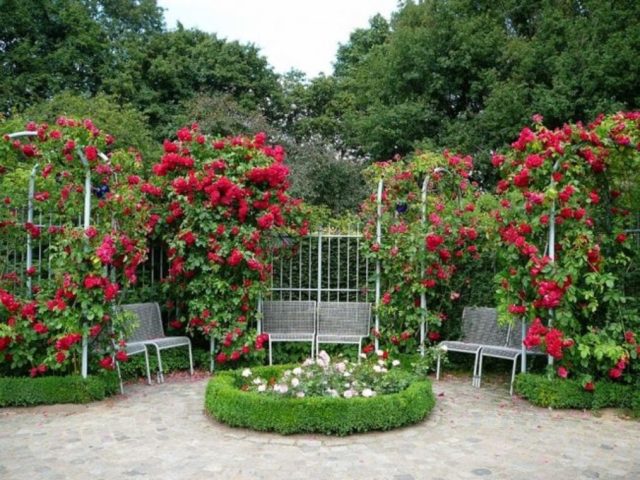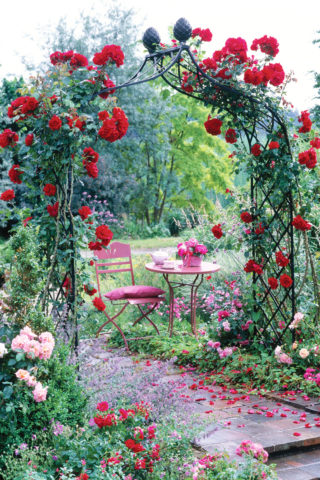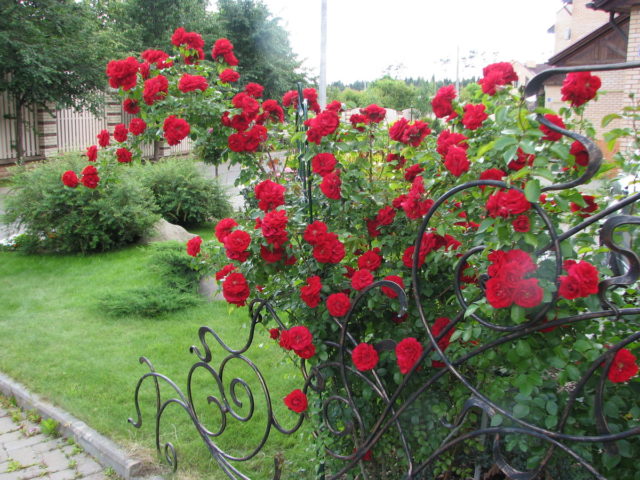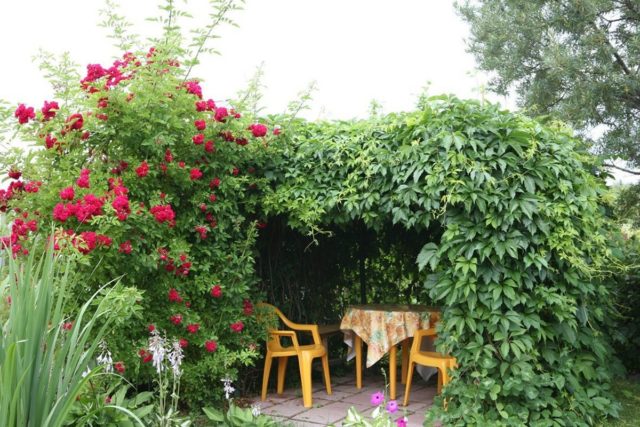Content
- 1 Breeding history
- 2 Description and characteristics of the climbing rose variety Flamentants
- 3 Advantages and disadvantages of the variety
- 4 Reproduction methods
- 5 Planting and caring for the climbing rose Flamentanz
- 6 Pests and diseases
- 7 Roses Flamentants in landscape design
- 8 Conclusion
- 9 Reviews of the climbing rose Flamentanz
Climbing rose Flamentants is a tall plant used for decoration of gardens and personal plots, as well as in floristry for drawing up bouquets. The variety is distinguished by good immunity and frost resistance, it is common in the European, Central parts, the Central zone and the North Caucasus.
Breeding history
A hybrid crop variety is the result of German selection. The originator of the climbing rose is considered to be Wilhelm Cordes. The varietal name in translation sounds like "fiery dance". The climbing rose was created in the 50s of the last century under the official name KORflata; at exhibitions and the flower market it is better known as Flammentanz. The copyright holder is W. Kordes' Sohne Rosenschulen GmbH & Co KG "(Cortes and sons).
Description and characteristics of the climbing rose variety Flamentants
The variety is common in all climatic zones (with the exception of the Far North). The climbing rose has a high frost resistance, which allows it to be grown in regions with a temperature of at least -28-30 0C. The main distribution of the Flamementz variety is noted in the fourth climatic zone.
Description, photo of the variety in design and reviews of the climbing rose Flamentants will help determine the choice for planting on the site.
External characteristic:
- The culture grows as a voluminous bush, the width of which reaches 1.5 m. Shoot formation is active, perennial lashes can grow up to 2.5 m in a temperate climate, up to 4 m in the south.
- The stems of the climbing rose are brown, stiff, the thorns are hard, long, prickly.
- The foliage is dense, medium-sized, round, with a sharp top.
- Plates are located on long petioles, 3-5 pcs., Light green color. The leaves have a pronounced central vein, the edges are jagged.
- The flowers of the climbing variety are large - 8 cm in diameter, double type, bright red with a burgundy tint. The central part is open, with numerous short filaments and brown anthers.
- Inflorescences are paniculate, long, consist of 3-5 buds, drooping when the flowers bloom.
Climbing rose Flamentanz blooms once a season from early June to July. Flowers bloom alternately, the period on average lasts 30–35 days. The main budding is on last year's stems. Old lashes bloom, but the arrangement of inflorescences on them is less dense.
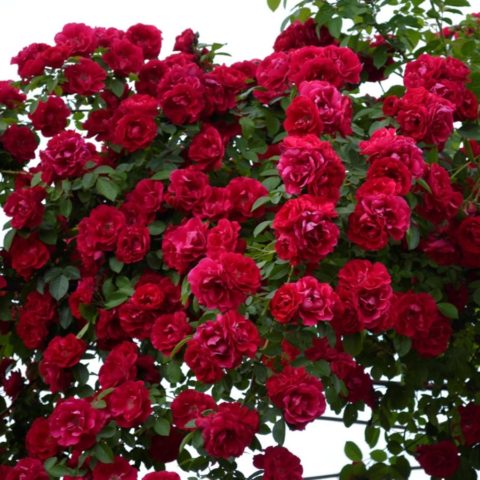
Throughout the entire life cycle, Flamement flowers do not change color, do not fade or fade in the sun
The climbing rose is moderately drought-resistant. The variety does not respond well to the drying out of the root ball, so additional watering is required. The abundance of budding is not affected by changes in night and day temperatures. The climbing rose calmly tolerates gusts of wind, but does not like drafts.
The Flamentants variety grows on any type of soil with good drainage and aeration. In order for the flowers to be bright and large, the rose needs additional nutrition. Therefore, top dressing is periodically carried out. The climbing rose is demanding on the acidity of the soil. The Flamency grows only on neutral ground.
A site with a sufficient supply of ultraviolet radiation is allocated for the plant, but the bush should be slightly shaded at noon. Burns are possible on the crown.Climbing Flamentanc grows poorly in areas with a close location of groundwater.
If all biological requirements are met, the rose does not get sick and blooms fully in the fourth year of growth.
Advantages and disadvantages of the variety
Climbing Flamentanz is the brightest representative of the group of red roses. The life cycle of a plant is perennial; the culture does not need a transplant. The rose maintains an abundance of flowering for up to twelve years.
The main advantages of Flamenants include:
- high frost resistance;
- good budding, independent of weather conditions;
- stress resistance and strong immunity;
- lush bright inflorescences;
- long flowering period;
- decorative crown;
- large, double flowers that do not freeze during prolonged rains;
- versatility of use. The variety is suitable for landscaping and cutting.
Minuses:
- blooms only once on last year's shoots;
- support is required;
- does not tolerate absolute shade and waterlogged soil;
- the presence of thorns.
Reproduction methods
A hybrid seedling is not suitable for generative propagation. A climbing crop grown from seeds does not retain varietal characteristics. Flamentants are propagated only vegetatively. In the southern regions, layering can be used for this purpose. In the spring, the stiff stem is fixed to the surface and covered with soil. They are insulated for the winter so that the root threads do not die. At the beginning of the season, when sprouts appear, plots are cut and planted.
The main breeding method is cuttings. It is more effective for both the south and cold regions. The material is harvested after flowering. Activities are carried out during the pruning of a rose. Cuttings 10–12 cm long are taken from last year's shoots. The lower part is cut at an angle. They are planted in a container with fertile soil. Before frosts, containers are lowered into the basement.

Two-year-old rose seedlings are planted on the site
Planting and caring for the climbing rose Flamentanz
The climbing variety is planted near the support at an angle of 300... If placed near the wall, then they retreat enough so that rainwater from the roof does not fall on the root. Planted in spring or autumn. For regions where winter temperatures can drop to -28 0C, it is preferable to carry out work at the beginning of the season, approximately in the middle or at the end of April.
A pit 35–40 cm deep is drained, a layer of peat mixed with compost is covered, a complex mineral fertilizer is added.
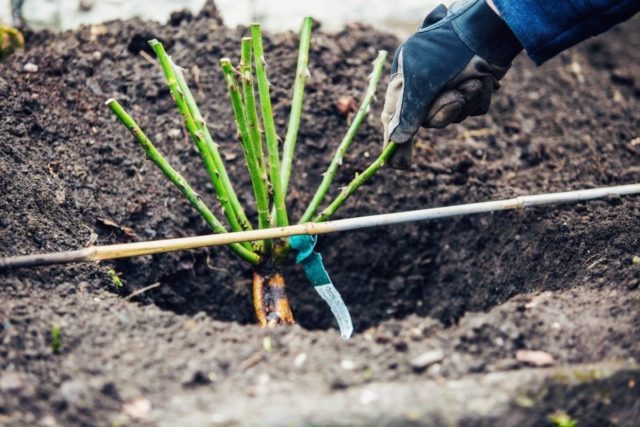
Before planting, the Flamentanz rose is shortened to six vegetative buds
Growing Climbing Flamentanz:
- Watering is necessary in dry weather twice a week. Each bush will require 20 liters of water.
- The root circle is mulched. This event will save you from constant loosening. Weeds are removed by the root.
- They begin to feed the rose from the second year. In the spring, nitrogen agents and liquid organic matter are introduced. During budding, fertilize with phosphate preparations. Potassium and phosphorus are used in autumn.
Before frosts, they remove the lashes from the support, put them on the ground, make a ridge over them (spud). Install arcs and cover with any waterproof material.
Pruning rose Flamenants
The main pruning of Climbing Flamenants is carried out after flowering. Withered inflorescences are removed so that the plant does not waste nutrients on them, this procedure is relevant for a young culture. An adult bush with a developed root system fully provides a rose, so the fruits can be left as an additional decoration.
Flamentant blooms on stems for 1-3 years. Older lashes are cut completely. Young shoots are not touched, the main buds will form on them next spring. At the beginning of the season, sanitary cleaning is carried out, dry and frozen areas are removed.
Pests and diseases
Hybrid groups are characterized by better immunity than varietal ones.If the site is correctly chosen, then the climbing rose Flamentanz does not get sick. In the shade and on waterlogged soil, the rose is affected by powdery mildew. In rainy summers, black spotting may occur. In order to prevent the spread of fungal infection, the rose is treated at the beginning of growth and before flowering with "Fitosporin".
Insects infect the Flamentanz, like any cultivar. With the massive spread of pests on a rose, they parasitize:
- rose leaf roll. Eliminate with Iskra;
- spider mite. Against him, "Agraverine" has proven itself well;
- aphids are less common. The rose is treated with "Confidor".
In the spring, colloidal sulfur is used for preventive purposes.
Roses Flamentants in landscape design
The Flamentanz hybrid blooms once a season. The bush is dense and densely leafy, the fruits are very large, hanging in clusters on the shoots. The plant has a decorative appearance from spring to late autumn. This quality is highly valued by gardeners and designers, therefore, the climbing variety Flamentants is often found in gardens throughout Russia.
A climbing rose in design can be used in the following cases:
- To create arches of all kinds of designs.
- For decorating high, solid fences.
- For the zoning of the territory. The climbing variety looks good on a wide trellis.
- As a decoration for the walls of buildings.
- The climbing rose is suitable for decorating recreation areas.
- Create a color accent on lawns.
- Decorate balconies.
- Decorate gazebos and pergolas.
- Create decorative fences.
Conclusion
Climbing rose Flamementz is a hybrid of German selection with a long biological cycle. The plant is tall, sprawling, for cultivation, a support is needed to support the whip. The variety is used for vertical gardening and cutting.
